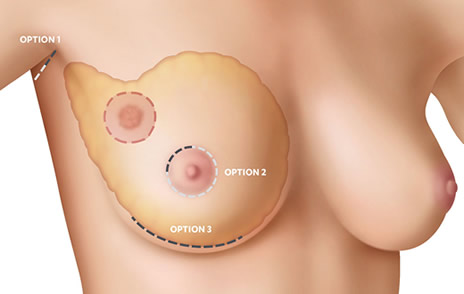Hidden Scar
What is Hidden Scar Surgery?
Hidden Scar breast cancer surgery is an advanced approach to removing breast cancer. Breast cancer can be surgically removed with a mastectomy procedure (all of the breast tissue is removed) or a lumpectomy procedure (only part of the breast tissue is removed). With the Hidden Scar approach, the incision is placed in a location that is hard to see, so that the scar is not visible when your incision heals. As a result, you have little to no visible reminder of the surgery or your cancer.
The Hidden Scar approach can be performed for a nipple sparing mastectomy or a lumpectomy procedure. Patients who undergo the Hidden Scar approach do not have a higher risk of cancer recurrence than patients who undergo any other type of technique. Patients may qualify for Hidden Scar breast cancer surgery based on the size and location of the tumor, the breast shape, and the breast size.
Hidden Scar Procedures
St. Mary’s Breast Center provides patients with Hidden Scar Lumpectomy and Hidden Scar Nipple Sparing Mastectomy procedures. St. Mary’s surgeons have been extensively trained in these Hidden Scar procedures to ensure the best surgical outcome.
Hidden Scar Lumpectomy

Figure 1
In a lumpectomy procedure, the surgeon will remove the breast cancer tumor and a small portion of healthy tissue surrounding the tumor (margin), but will save the majority of the breast, including the nipple area.
A lumpectomy can be performed as a Hidden Scar procedure. This means that the incision is made in a place that is hard to see. There are three different locations for a lumpectomy incision that make the scar less visible (refer to Figure 1):
- Inframammary Fold: The natural crease beneath the breast
- Periareolar: Along the edges of the areola
- Axilla: In the armpit, usually hidden in a natural fold
Patients may be considered for a Hidden Scar Lumpectomy if the size of the tumor is small enough relative to the size of the breast, and if the cancer has not spread to other areas of the breast.
Hidden Scar Nipple Sparing Mastectomy
In a mastectomy procedure, the surgeon removes the breast cancer tumor by removing all of the breast tissue. There are several mastectomy options: a simple (total) mastectomy, a skin sparing mastectomy, and a nipple sparing mastectomy (NSM). A Nipple Sparing Mastectomy is a type of mastectomy procedure where the surgeon removes all of the breast tissue, but does not remove the nipple.

Figure 2
A Nipple Sparing Mastectomy can be performed as a Hidden Scar Procedure. This means that the incision is made in a place that is hard to see. There is one location for a Nipple Sparing Mastectomy that make the scar less visible (refer to Figure 2):
- Inframammary Fold: The natural crease beneath the breast
Patients may be considered for a Hidden Scar Nipple Sparing Mastectomy if no cancerous tissue is found in the nipple. Additionally, a Hidden Scar Nipple Sparing Mastectomy is a safe approach that can be used in patients seeking a prophylactic mastectomy (a mastectomy that is performed when cancer does not exist, if the patient has a family history or carries the BRCA gene), in women with DCIS (non-invasive cancer), or small tumors that do not lie directly beneath the nipple.
Hidden Scar Breast Reconstruction
In a Hidden Scar breast reconstruction procedure, the breast is recreated to have the natural look and feel the patient desires while hiding all the scars. The same incision in the natural crease beneath your breast (inframmary incision) that the surgeon used to perform the Hidden Scar Mastectomy procedure will be used.
The breast can be reconstructed with an implant or with the patient’s own autologous tissue. In autologous reconstruction, the breast is recreated using fat and/or muscle from the patient’s back, abdomen or buttocks. With an implant, tissue expanders may first be used to create room in the breast pocket for the implant. Once there is enough room, a second operation is performed to remove the tissue expander and insert the implant. Some women do not require tissue expanders before receiving a breast implant and will only need one procedure.
